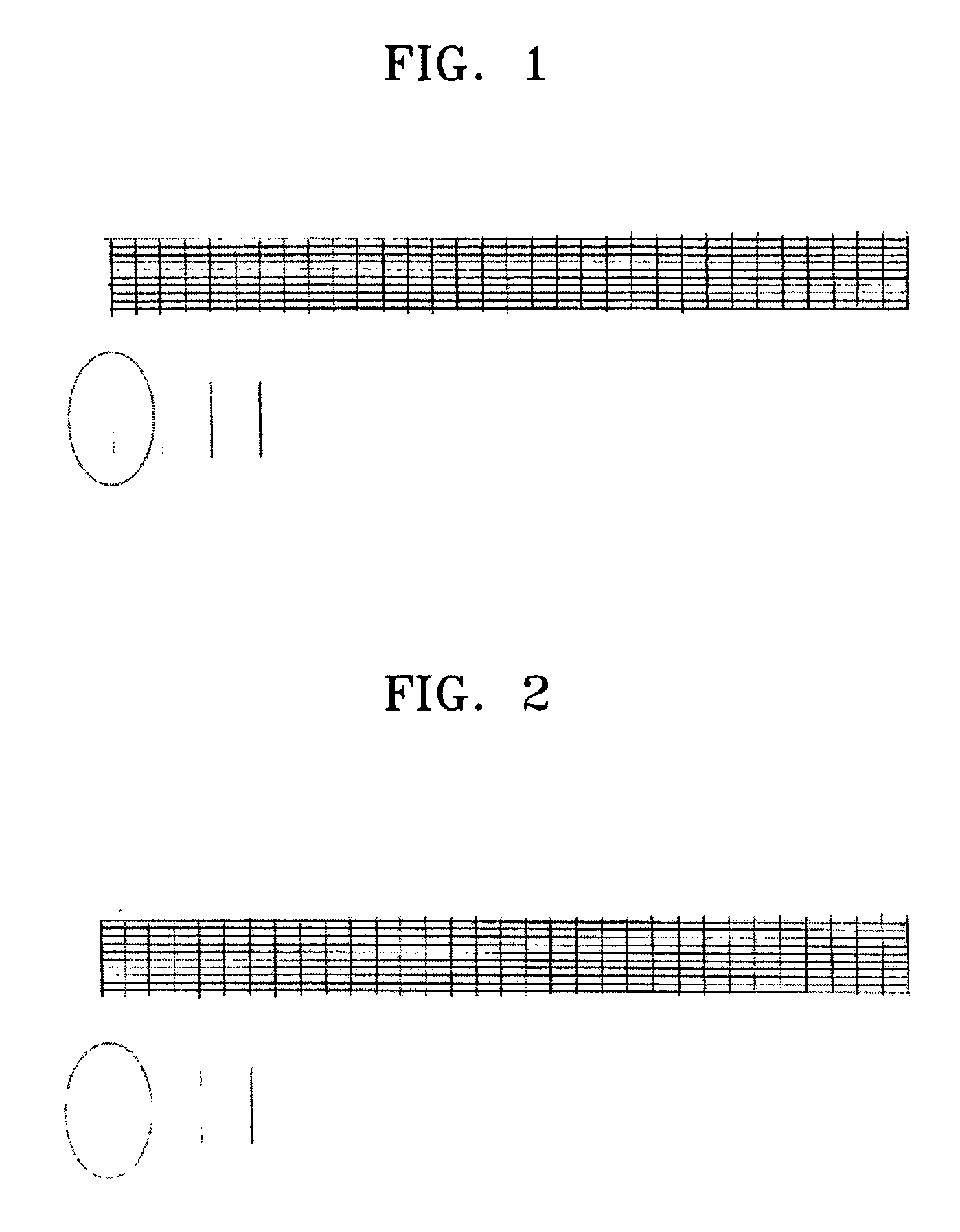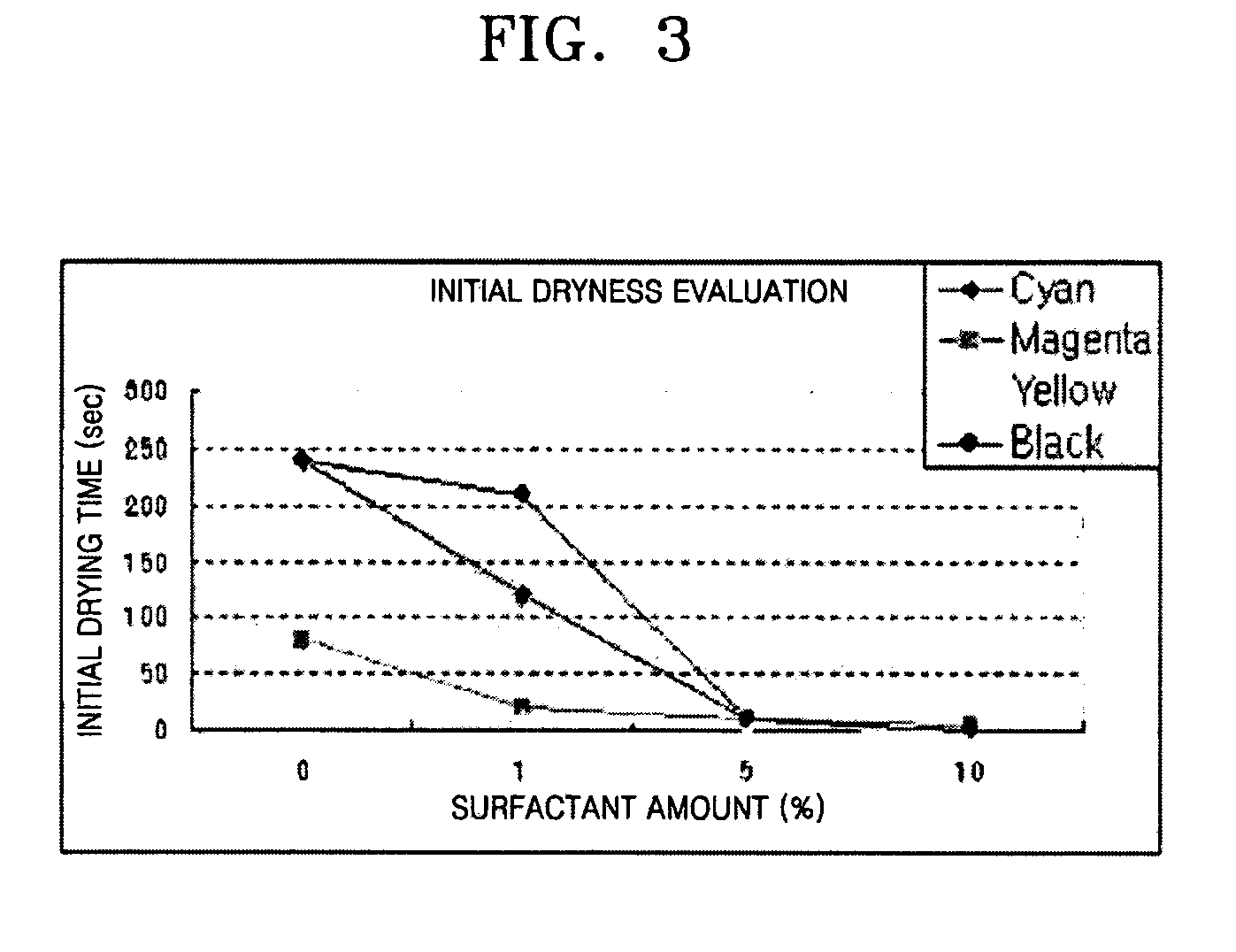Ink composition
a technology of composition and ink, applied in the field of ink composition, can solve the problems of reducing the speed of producing ink droplets, degrading printing quality, piezoelectric inkjet method, etc., and achieve the effect of reducing the amount of smearing
- Summary
- Abstract
- Description
- Claims
- Application Information
AI Technical Summary
Benefits of technology
Problems solved by technology
Method used
Image
Examples
experimental example 1
Image Performance Evaluation
[0121] The ink compositions obtained in examples 1-17 and comparative examples 1-6 are filled into ink cartridges such as, for example, the M-50 (available from Samsung Electronics), and a dot pattern can be printed on premium inkjet paper (available from HP) in a printer such as, for example, an MJC-2400, available from Samsung Electronics. Then, the dot size, the dot size uniformity, and the production of satellites, which are small dots produced with a main dot, can be determined using an instrument such as (XC-003) available from imageXper, and the results that can be obtained are illustrated in Table 2.
A=dot size (diameter)
[0123]∘: 50 μm≦A≦75 μm
[0124] X: 25 μm≦A≦55 μm
[0125] XX: A<25 μm
[0126] B=Dot size uniformity
[0127]⊚: B<10 μm
[0128]∘: 10 μm≦B≦20 μm
[0129] X: 20 μm≦B≦30 μm
[0130] XX: 30 μm
[0131]⊚: excellent
[0132]∘: acceptable
[0133] X: not acceptable
[0134] XX: worse
experimental example 2
Smear Evaluation
[0135] The ink compositions obtained in examples 1-17 and comparative examples 1-6 were filled in ink cartridges M-50 (available from Samsung Electronics) and a bar image (3 cm×20 cm) was printed with a printer (MJC-2400C, available from Samsung Electronics). The print was dried and the optical density (OD) thereof was measured and denoted as OD1. Immediately after a bar image (3 cm×20 cm) was printed on another piece of paper, 50 sheets of general paper were mounted on the print for approximately 10 sec and then removed. The OD of the print was measured and denoted as OD2. The ODs were compared (OD2 compared with OD 1) and the results are illustrated as percentages in Table 2.
[0136] D=Smearing=(OD2 / OD1)×100 (%)
[0137]⊚: 70
[0138]∘: 50≦D≦70
[0139] X: 30≦D≦50
[0140] XX: D<30
experimental example 3
Storage Stability Evaluation
[0141] The ink compositions obtained in examples 1-17 and comparative examples 1-6 were filled in ink cartridges M-50 (available from Samsung Electronics) and stored for two weeks at different temperatures, for example, room temperature (25° C.), a low temperature (−18° C.), and a high temperature (38° C.). When printing was performed using these ink compositions (MJC-2400C, available from Samsung Electronics), it was determined how many nozzles were unable to discharge ink due to clogging. The results are illustrated in Table 2.
E=Storage stability=(total number of nozzles−number of clogged nozzles) / total number of nozzles×100 (%)
[0142]⊚: 90
[0143]∘: 70≦E≦90
[0144] X: 50≦E≦70
[0145] XX: E<50
PUM
| Property | Measurement | Unit |
|---|---|---|
| surface tension | aaaaa | aaaaa |
| surface tension | aaaaa | aaaaa |
| surface tension | aaaaa | aaaaa |
Abstract
Description
Claims
Application Information
 Login to View More
Login to View More - Generate Ideas
- Intellectual Property
- Life Sciences
- Materials
- Tech Scout
- Unparalleled Data Quality
- Higher Quality Content
- 60% Fewer Hallucinations
Browse by: Latest US Patents, China's latest patents, Technical Efficacy Thesaurus, Application Domain, Technology Topic, Popular Technical Reports.
© 2025 PatSnap. All rights reserved.Legal|Privacy policy|Modern Slavery Act Transparency Statement|Sitemap|About US| Contact US: help@patsnap.com



